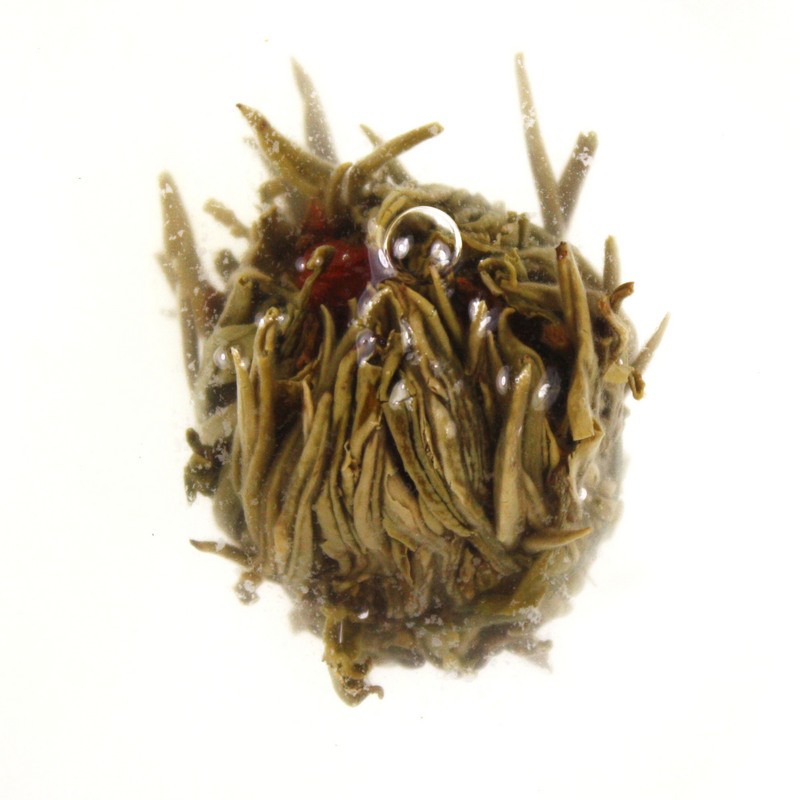White Tea Brewing Guide

1 Teaspoon
Add 1 teaspoon per person and one for the pot.

70⁰c - 80⁰c
Boil using fresh water, at a temperature of 70⁰c - 80⁰c.

2 - 3 Mins
Steep for 2 - 3 minutes, depending on personal preference.
About Product
-
Product Description
This Chinese Flower Tea is a remarkable handmade creation. When brewed, the outer White Tea leaves burst open to reveal a stunningly red chrysanthemum flower. To best enjoy this Flowering Tea, we recommend using a glass vessel so that one can appreciate its true majesty.
This incredible Flowering Tea, also known as Treasure Tea and Blooming Tea, is as beautiful in taste as it is in appearance. It originates from the Fujian province of China (similar to most Flowering Teas), where experienced workers can make up to 400 of these Teas a day!
Chrysanthemum Flower
China is home to 17 different species of chrysanthemum. Two of the most used species, Chrysanthemum indicum and Chrysanthemum morifolium, grow predominantly in the provinces of Anhui, Gansu, Henan, Jiangxi, Shaanxi and Zhejiang.
The Chongyuan Festival (also called the Double Ninth Festival, referring the lunar calendar) in China celebrates the chrysanthemum flower. In particular, this festival highlights the significance of the flower through an enchanting, age-old tale.
The story revolves around a young man named Huan Jing who lived in a village near the River Ru, Henan province. One fateful day, his village suffered from a horrendous plague brought on by a demon living in the nearby waters.
Huan tragically lost his parents to the disease. In his anger, he decided to seek help from an immortal sage to find out how to kill the beast. He travelled great distances to reach the sage, who in turn told the young man how to fight the demon. Huan Jing also discovered that the monster would return to the village waters on the ninth day of the ninth month. Time was of the essence.
Huan returned home. He instructed his fellow villages to climb up a nearby mountain and bring with them dogwood leaves and chrysanthemum liquor. As the monster emerged from the water, the scent of the flowery wine made the creature dizzy. At that moment, the young man killed the beast with a single strike from his sword.
Today, the magnificent Chongyuan Festival honours all things made from chrysanthemum flowers. This includes Chrysanthemum Wine (like the wine that killed the beast), Chrysanthemum Flower Tea and, of course, this Flowering Tea, also!
White Tea
This Flowering Tea wouldn’t be the same without the White Tea leaves that surround it. Indeed, White Tea puts the ‘Tea’ in Flowering Tea! It comes from the Camellia sinensis plant, like any other ‘real’ Tea. However, White Tea is the least processed. This processing (or, rather, lack of), coupled with its very short oxidation period, results in a brew that is unmistakably delicate and very fresh.
Contrary to popular belief, the name ‘White Tea’ does not come from the light liquor it produces. Instead, it stems from the silvery pekoe (hairs or dust) that grow on the unopened buds of the Tea leaf used in its making.
Type of Tea: Flowering Tea (White Tea).
Origin: China.
How to Brew
Brewing Instructions: Brew using water at a temperature of approximately 90 degrees while watching the Tea flower unfold. Some choose to brew it several times.
How to Serve: This beverage tastes best as it is.
Tasting Notes: Expect delicate tastes with refined floral notes.
Colour in Cup: Pale Green liquor with yellow highlights, light in tone.
Benefits of Flowering Tea
The fluoride found in White Tea has a high bioavailability, which can prevent cavities. It’s important to note, however, that research published in the “Dental Research Journal” has suggested that only 34% of fluoride in White Tea remains after brewing. It may not sound like a lot, but it could be enough to avoid a trip to the dentist!
-
Delivery Information
We offer reliable delivery services through Royal Mail to ensure that your orders reach you on time.
Here are the main points you should be aware of:
- Standard UK Delivery: £3.95 excluding delivery charge.
- Delivery Times: Orders are processed and dispatched within 2-5 working days but they may take longer during busy times. It is worth noting that all our orders are packed by hand in order to maintain the quality.
- Free Delivery: We are delighted to provide free shipping for UK orders over £35*. Moreover, customers from Europe can enjoy free shipping for any purchase above €75*. Furthermore, we offer free delivery in the USA for all purchases exceeding $125*. Please note terms and conditions may apply.
- Tracking: When your package is sent you will receive a tracking number via email so as to keep tabs of its progress.
International Shipping
We do ship worldwide meaning our products can be accessed by anyone around the world.
Here are some important details:
- Delivery Times: International deliveries vary based on destination, generally taking between 7-14 working days.
- Shipping Costs: International shipping costs are calculated at checkout based on your location and weight of your order. View full delivery charges for your location.
- Customs and Import Duties: Remember customs or import duties may exist depending on regulations in your country; these charges are borne by the customer.
Returns Policy
Your satisfaction is our top priority, however if for any reasons you’re not completely happy with your purchase, simply follow our returns procedure:
- Eligibility: Items returned within 30 days of receipt must remain unopened and in their original condition.
- Process: In order to return an item contact our customer service department using your unique order number after which detailed instructions will be given concerning returning them back to us securely.
- Refunds: Our aim is to refund you within 5-7 working days upon successful reception of returned goods. The refund amount will be credited to your original payment method.
For any other Enquiries or help please contact our Customer Support Team always at your service.
-
Product Reviews

 Loose Leaf Tea
Loose Leaf Tea Pyramids
Pyramids Tea Bags
Tea Bags Africa
Africa Assam
Assam Ceylon
Ceylon Chinese
Chinese Darjeeling
Darjeeling European
European Indian
Indian Japan
Japan Nepal
Nepal South East Asia
South East Asia Ayurveda Tea
Ayurveda Tea Black Tea
Black Tea Chai Tea
Chai Tea Flowering Tea
Flowering Tea Fruit Tisanes
Fruit Tisanes Green Tea
Green Tea Herbal Tea
Herbal Tea Matcha Tea
Matcha Tea Oolong Tea
Oolong Tea Organic Tea
Organic Tea Pu erh Tea
Pu erh Tea Rooibos Tea
Rooibos Tea White Tea
White Tea Asian Coffee
Asian Coffee Caribbean Coffee
Caribbean Coffee Central American Coffee
Central American Coffee South American Coffee
South American Coffee Coffee Blends
Coffee Blends Decaffeinated Coffee
Decaffeinated Coffee Espresso Coffee
Espresso Coffee Ethically Sourced Coffee
Ethically Sourced Coffee Flavoured Coffee
Flavoured Coffee Organic Coffee
Organic Coffee Single Origin Coffee
Single Origin Coffee Chocolate 1
Chocolate 1 Chocolate 2
Chocolate 2 Chocolate 3
Chocolate 3 Chocolate 4
Chocolate 4 Chocolate 5
Chocolate 5 Chocolate 6
Chocolate 6 Chocolate 7
Chocolate 7 Chocolate 8
Chocolate 8 Chocolate 9
Chocolate 9 Loose Tea Filters
Loose Tea Filters Tea Accessories
Tea Accessories Tea Bricks
Tea Bricks Tea Caddies
Tea Caddies Tea Caddy Spoons
Tea Caddy Spoons Tea Gift Ideas
Tea Gift Ideas Tea Infusers
Tea Infusers Tea Strainers
Tea Strainers




